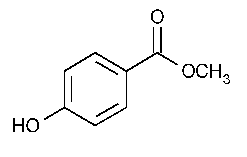Methylparaben
»Methylparaben contains not less than 99.0percent and not more than 100.5percent of C8H8O3.
Packaging and storage—
Preserve in well-closed containers.
Identification—
B:
The principal spot obtained in the chromatogram of Test solution Bprepared as directed in the test for Chromatographic puritycorresponds in size and RFvalue to that of the principal spot obtained from Standard solution B.
C:
Transfer about 10mg to a test tube,add 1mLof sodium carbonate TS,mix,boil for 30seconds,and cool (Test solution A).Transfer about 10mg to a second test tube,add 1mLof sodium carbonate TS,and mix (Test solution B).[NOTE—The Methylparaben partly dissolves in Test solution B.]Prepare a solution of 4-aminoantipyrine in pH9.0alkaline borate buffer containing 1mg per mL.Simultaneously add 5mLof the 4-aminoantipyrine solution and 0.5mLof potassium ferricyanide TSto Test solution Aand Test solution B,and mix:Test solution Bbecomes yellow to orange-brown and Test solution Abecomes orange to red,with the color of Test solution Abeing clearly more intense than any similar color that may be obtained with Test solution B.
Color of solution—
Dissolve 1g in alcohol,dilute with alcohol to 10mL,and mix (Methylparaben solution).This solution is clear and not more intensely colored than a solution prepared immediately before use by mixing 2.4mLof ferric chloride CS,1.0mLof cobaltous chloride CS,and 0.4mLof cupric sulfate CSwith 0.3Nhydrochloric acid to make 10mL,and diluting 5mLof this solution with 0.3Nhydrochloric acid to make 100mL.Make the comparison by viewing the solutions downward in matched color-comparison tubes against a white surface (see Color and Achromicity á631ñ).
Acidity—
To 2mLof Methylparaben solutionprepared in the Color of solutiontest add 3mLof alcohol,5mLof carbon dioxide-free water,and 0.1mLof bromocresol green TS,and titrate with 0.10Nsodium hydroxide:not more than 0.1mLis required to produce a blue color.
Residue on ignition á281ñ:
not more than 0.1%.
Chromatographic purity—
Test solutions—
Prepare a solution of Methylparaben in acetone containing 10mg per mL(Test solution A).Transfer 1.0mLof this solution to a 10-mLvolumetric flask,dilute with acetone to volume,and mix (Test solution B).
Standard solutions—
Transfer 0.5mLof Test solution Ato a 100-mLvolumetric flask,dilute with acetone to volume,and mix (Standard solution A).Dissolve an accurately weighed quantity of USP Methylparaben RSin acetone,and mix to obtain a solution having a known concentration of about 1mg per mL(Standard solution B).Transfer about 10mg of USP Ethylparaben RS,accurately weighed,to a 10-mLvolumetric flask,dissolve in 1mLof Test solution A,dilute with acetone to volume,and mix (Standard solution C).
Procedure—
Separately apply 2µLof each Test solutionand 2µLof each Standard solutionto a thin-layer chromatographic plate (see Chromatography á621ñ)coated with a 0.25-mm layer of chromatographic octadecylsilanized silica gel mixture.Develop the chromatogram in a solvent system consisting of a mixture of methanol,water,and glacial acetic acid (70:30:1)until the solvent front has moved about three-fourths of the length of the plate.Remove the plate from the chamber,mark the solvent front,and allow the solvent to evaporate.Examine the plate under short-wavelength UVlight,and compare the intensities of any secondary spots observed in the chromatogram of Test solution Awith that of the principal spot in the chromatogram of Standard solution A:the intensity of any individual secondary spot in the chromatogram of Test solution Ais not greater than that of the principal spot obtained in the chromatogram of Standard solution A(0.5%).The test is not valid unless the chromatogram obtained with Standard solution Cshows two clearly separated principal spots.
Organic volatile impurities,Method IVá467ñ:
meets the requirements.
Assay—
Transfer about 2g of Methylparaben,accurately weighed,to a flask fitted with a ground-glass stopper and equipped for refluxing under a water-cooled condenser.Add 40.0mLof 1Nsodium hydroxide VS,and reflux for 1hour.Cool to room temperature,and rinse the condenser with water.Titrate the excess sodium hydroxide with 1Nsulfuric acid VS,continuing the titration until the second point of inflection and determining the endpoint potentiometrically (see Titrimetry á541ñ).Perform a blank determination (see Residual Titrationsunder Titrimetry á541ñ).Each mLof 1Nsodium hydroxide is equivalent to 152.2mg of C8H8O3.
Auxiliary Information—
Staff Liaison:Justin Lane,B.S.,Scientific Associate
Expert Committee:(EMC)Excipients:Monograph Content
USP28–NF23Page 3038
Pharmacopeial Forum:Volume No.30(4)Page 1445
Phone Number:1-301-816-8323
